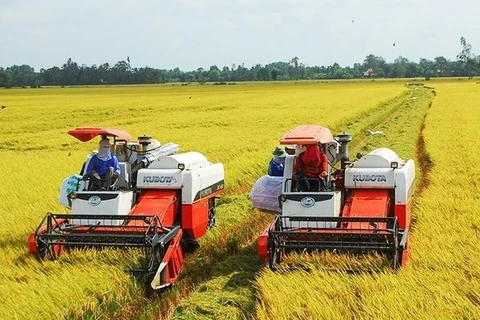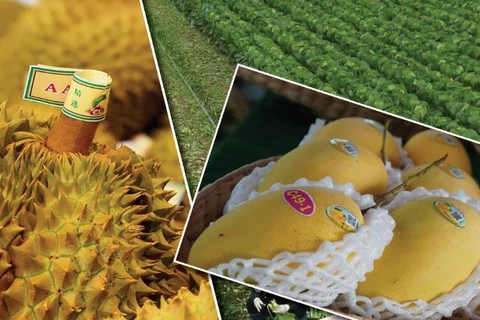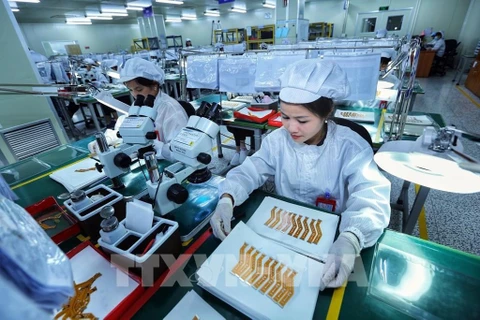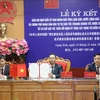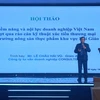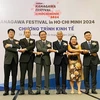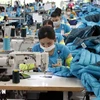 The fishery industry sets an seafood export target of 9.5 billion despite predicting that this industry will continue to face many difficulties in 2024. (Photo: VNA)
The fishery industry sets an seafood export target of 9.5 billion despite predicting that this industry will continue to face many difficulties in 2024. (Photo: VNA) To reach this target next year, it is forecast to face many difficulties and challenges as the export value target in 2023 has not been completed. Specifically, the export value in 2023 is estimated to reach about $355 billion, down 4.5% over the same period last year. It does not reach the planned growth target of 6%.
According to the ministry, along with taking full advantage of existing free trade agreements (FTAs), FTAs with new markets such as Israel and the UAE will create more opportunities to promote trade and investment, especially exports, of Vietnam in 2024.
Good political relations have been strengthened and upgraded with major partners such as China, the US and the EU, creating a premise for expanding economic, trade and investment cooperation.
Now, a number of Vietnam’s key export industries have set growth targets for 2024.
Truong Van Cam, vice chairman and general secretary of the Vietnam Textile and Apparel Association (VITAS), said that with 2023 export turnover reaching 40.3 billion USD, the industry sets an export target of 2024 to reach 44 billion USD, an increase of 9.2%.
The seafood industry sets an export target of 9.5 billion USD despite predicting that this industry will continue to face many difficulties in 2024, especially the European Commission (EC) maintaining a yellow card warning for exploited seafood products in Vietnam.
The Ministry of Industry and Trade believes that by 2024, the world and domestic economic situation will have more positive factors for import and export activities. Of which, the US Federal Reserve (FED) has issued a message to stop raising interest rates and consider reducing interest rates in 2024.
However, the ministry has also noted the trend of having more and more trade protection. Some countries bring investment back home, and erect trade barriers to protect and promote their country's production.
Therefore, Nguyen Cam Trang, deputy director of the MoIT's Import-Export Department, emphasised that to achieve the export growth target of 6% next year, the ministry will promote negotiations and signing of new agreements, commitments, and trade links, sign FTAs and trade agreements with other potential partners, such as the UAE and South America, to diversify markets, products and supply chains.
The Import-Export Department will continue to support the businesses to take advantage of commitments in the FTA to boost exports, and shift to official exports associated with brand building.
Trade promotion is one of the important activities to promote export growth.
Therefore, the Department of Trade Promotion in 2024 will exchange and coordinate with localities, industry associations and businesses to evaluate the export situation and support them to develop markets and promote the consumption of goods.
In addition, the Department of Trade Promotion will regularly update policies and changes in standards and conditions of export markets so that businesses and industry associations can understand and have suitable plans and strategies for production and business.
For the textile and garment industry, to achieve the export target of 44 billion USD, Cam said VITAS will promote solutions on market, human resources, science - technology and raise capital, and investment in sustainable development.
The textile and garment industry will continue to diversify its supply of raw materials and accessories as well as expand export markets, by improving marketing capacity and seeking for direct customers, Cam said.
Currently, requirements on green and sustainable economic development are gradually forming new rules in the trade. Many economies around the world have set stricter environmental regulations for imported goods. Green export is an inevitable trend, so Vietnam is not out of this game.
VITAS representative also hopes support in interest rate will be implemented faster to create favourable conditions for the businesses in expanding production and having more resources for green transformation according to new regulations of the world market.
Meanwhile, Trang proposed the MoIT to have supports for the businesses to overcome new trade barriers in import markets.
The ministry will support for them in the development and implementation of large-scale trade promotion activities for key products and industries in target markets, she said.
Minister of Industry and Trade Nguyen Hong Dien said that Vietnam trade offices abroad need to provide information about the market and new regulations and policies of the host country. Thereby, they have early warning of new barriers from partners, help State management agencies and the businesses to have appropriate policy responses, and improve efficiency in export activities.
Economic expert Dr Can Van Luc said that in addition to reduced export orders, many businesses face difficulties because the supply chain is still risky and input costs are high. In particular, the trend of greening and circular business is a big challenge for the enterprises.
Therefore, the enterprises need to diversify capital sources, markets, partners, and supply sources. They also need to proactively apply green production, green consumption, and circular business models to improve efficiency in production and export./.
VNA
